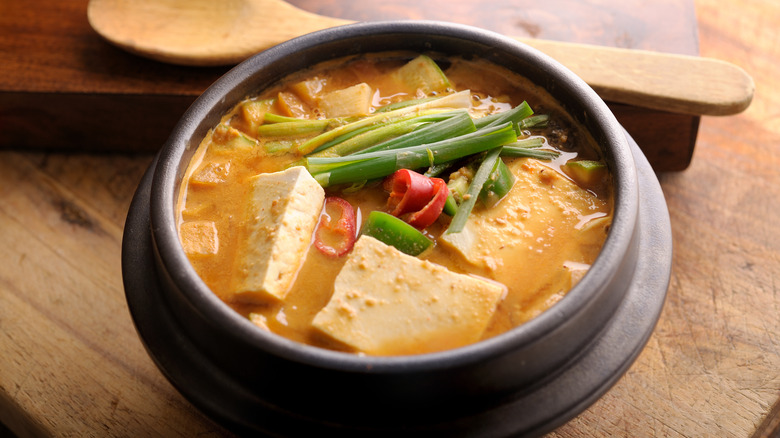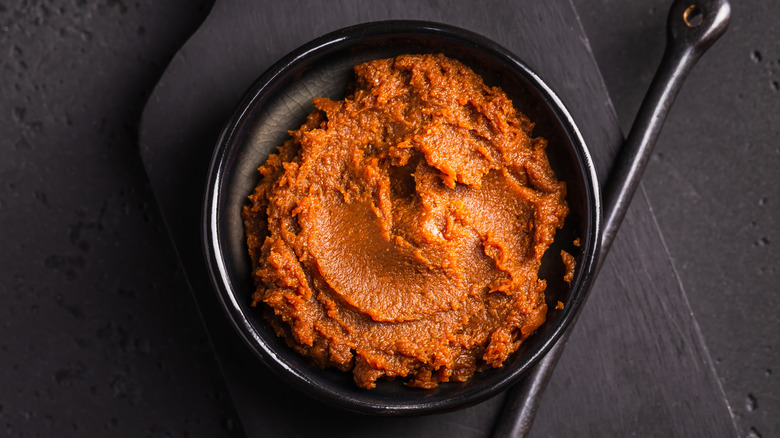The Difference Between Japanese Clear Soup And Miso
Soup is a central element of Japanese cuisine, usually served as breakfast. Two popular choices include miso soup and clear soup, both of which have a wonderful umami flavor. The former is made with miso paste, seaweed, shiitake mushrooms, tofu, and other ingredients that give it texture and taste. It's hearty and filling, with a savory taste. Japanese clear soup, on the other hand, is lighter and more watery — similar to broth. It also has a less intense flavor than miso soup, but you'll still get that umami taste.
Both soups have the same base ingredient: dashi, or stock. The difference lies in their texture, nutritional value, and flavor profile. For example, some miso soups feel more like a stew, abounding in vegetables. Osumashi, or clear soup, may contain vegetables, mushrooms, ginger, and other ingredients, but it's much thinner than miso. Its primary flavor comes from salt, sake, and soy sauce rather than miso paste.
Miso and Japanese clear soup differ in flavor
Miso soup consists of dashi and miso paste, or fermented soybean paste, which gives it an umami kick. Most recipes also call for vegetables, legumes, wakame seaweed, and protein sources like chicken, fish, or tofu. For instance, a savory miso soup can be made with napa cabbage, shrimp, miso paste, chicken breast, herbs, and other ingredients. The resulting flavor is rich, savory, and salty due to the miso paste.
However, different types of miso will impart different flavors to the dish. For example, white miso paste is rather sweet, whereas red miso has a salty taste. Brown rice miso, or genmai miso, on the other hand, boasts an earthy flavor with nutty notes. This thick paste is mixed into the stock, which typically contains dried bonito flakes, dried shiitake mushrooms, sun-dried fish, and other traditional ingredients.
Japanese clear soup starts with dashi, too, but apart from that, it's very different from miso soup. Typical ingredients include soy sauce, shiitake or shimeji mushrooms, leafy greens, bamboo shoots, corn, and daikon radish, depending on what's in season. The veggies are strained from the broth, resulting in a clear, light soup with a refreshing flavor profile. Its taste is more subtle than miso soup and depends largely on the vegetables used.
The health benefits of clear soup and miso
While both miso and Japanese clear soup taste delicious, miso soup tends to be more nutritious. Depending on the ingredients used, a cup of miso soup has around 77 calories, 6 grams of protein, less than 4 grams of fat, and 5.5 grams of carbs, including 1 gram of fiber. It's a good source of calcium, zinc, manganese, copper, iron, and B-complex vitamins.
Miso paste, one of its main ingredients, is rich in probiotics and supports gut health. Macrobiotic chef Yayoi Kaneko recommends adding dried sea kelp (kombu) to miso soup and serving it with brown rice to fully reap the benefits. "Miso is alkaline and warming, too," she told Abokichi. The soup will also fill you up quickly since you keep the vegetables in.
Japanese clear soup has very few (if any) vegetables, so it's less filling and lower in nutrients. A typical serving has around 55 calories, 3 grams of protein, 2 grams of fat, and 6 grams of carbs, depending on the recipe. Due to its high water content, it will keep you hydrated and quench your thirst. Apart from that, both miso and Japanese clear soup are high in sodium and should be consumed in moderation.


